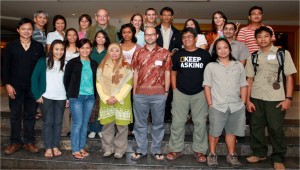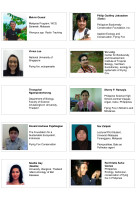Facilitators: Tammy Mildenstein (University of Montana), Sara Bumrungsri (Prince of Songkla University, Thailand), Paul Racey (University of Exeter, UK), CE Nuevo (Philippines), Sheema Abdul Aziz (Rimba, Malaysia), Tuanjit Sritongchuay (Prince of Songkla University, Thailand), Nick Rosenberger (U. Montana)
Workshop participants: The flying fox workshop included 23 participants working in 7 countries across SE Asia, representing 40 universities, 24 non-profit organizations, 9 government agencies, and 3 private corporations active in conservation in SE Asia. As a group we had a cumulative total of 204 years in bat research and conservation as well as experience in a wide array of flying fox-related research, including evolution, taxonomy and systematics, ecology, bat/human conflicts, ecosystem services, emerging infectious diseases, and community-based conservation. Check out the Field Guide below – longer bios can be downloaded as well.
SEABCRU Flying Fox Participant Bios
Workshop Objectives
The flying fox workshop focused on one of the main goals of the SEABCRU flying fox priority: the establishment of a standardized method for population abundance assessment (count) for large colonizing fruit bats in Southeast Asia. To that end, we invited participants who were involved in flying fox research and could contribute to discussions about count methodology and requirements for the regions in which they work. These participants are also the most likely to use the workshop outputs in their own research and conservation management activities.
To collate knowledge about flying fox populations in SE Asia and move toward a standardized population monitoring protocol, our workshop had four main objectives:
- Establish what is currently known about flying fox colonies across SE Asia
- Develop a population size/distribution database for SE Asia
- Share experiences in flying fox colony counting
- Identify what can and cannot be standardized in colony count methods
1. Establish what is known about flying fox colonies across SE Asia
We divided the workshop participants into three groups by region (Indochina: Vietnam, Cambodia, N. Thailand; Sundaland: Indonesia, Singapore, Malaysia, S. Thailand; Philippines). Within these groups, we summarized what is known about flying foxes in each country and discussed who the main stakeholders are and who is responsible for monitoring populations of threatened flying fox species. Overviews of flying fox conservation and management were provided to the workshop participants by a representative from each regional group.
2. Development of a population size/distribution database for SE Asia
We asked each group to summarize known flying fox population sizes and locations within their regions. Each group made a map of flying fox roosts and used a color code to describe whether the roosting population is well-known (i.e. verified, species composition and population sizes assessed) or not well-known (i.e. there is a purported roosting population of bats, but this remains unverified and species and population sizes are unknown or old (>5 years)).
All three regions have many more roosting populations of flying foxes that are unknown than populations that have been studied and quantified. More is known about roosts in the Philippines than in either of the other two regions, but even in the Philippines less than 1/3 of the flying fox populations have been formally surveyed and counted. The other two regions were both aware of many roosting populations but very few of these have been counted.
3. Share experiences with flying fox colony counting
We discussed our personal experiences with flying fox counting techniques as a whole group. Despite being a basic technique in surveying and monitoring flying fox populations, only 25% of the participants had experienced counting flying fox populations before. Across the SE Asian countries represented by our participants, it was agreed that the responsibility of monitoring bat populations fell generally on protected area managers and local government units. However, the group also recognized that in many cases, resources and training were lacking to conduct population monitoring, and it would therefore be more effective if local stakeholders (such as farmers, people’s organizations, and hunters) were also given the skills and encouragement to monitor their flying foxes.
4. Identify what can and cannot be standardized in colony count methods
In a group brainstorming session, we developed a list of constraints that local management offices across SE Asia would likely face in conducting flying fox population monitoring surveys. The final list included the levels of training, amount of time and equipment, and funding that would be available for field surveys.
Recognizing we must work within the local constraints identified above, we developed lists of what could and could not be standardized in a SE Asian fruit bat population survey protocol. The group consensus was that we should standardize the following:
- how much training should be given to observers
- how many days should be spent in reconnaissance prior to the counts
- a maximum distance observers should be from the bats when counting
- the equipment that is used in counts
- the types of methods that are used (e.g. direct, photographic counts, exit counts)
- the minimum amount of effort in a single count (i.e. # observers, # nights counted)
- the time of year when counts should be performed (e.g. pre- or post-birth pulse)
- the number of counts/year for monitoring and trend detection
- how the data are reported and analyzed
The group also recognized that the following aspects of colony counts are roost site specific and cannot be standardized:
- geographical location of the bats (which affects the types and quality of vantage points that can be developed)
- flight behavioral patterns of the bats (which affects which vantage points are used, count intervals for a particular flight path, and what time the counts should start)
- reproductive timing of the bats (which affects when a post-birth pulse count would occur at a particular roost)
- weather patterns (which affect bat flight times/paths/directions)
Presentations from the workshop are available as pdf files below:
- SEABCRU Flying Fox Workshop — opening – Tammy Mildenstein
- SEABCRU Flying Fox Workshop — counting Pteropus – Paul Racey
- SEABCRU Flying Fox Workshop — hunting ban — Sheema Abdul Aziz
- SEABCRU Flying Fox Workshop — FF vs agriculture – Tuanjit Srithongchuay
- SEABCRU Flying Fox Workshop — FF vs agriculture part b –Tuanjit
- SEABCRU Flying Fox Workshop — disease monitoring – Kevin Olival
- SEABCRU Flying Fox Workshop — knowledge gaps – Nick Rosenberger



